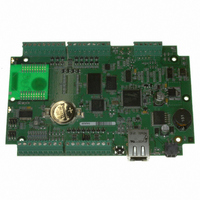20-101-1256 Rabbit Semiconductor, 20-101-1256 Datasheet - Page 47

20-101-1256
Manufacturer Part Number
20-101-1256
Description
COMPUTER SINGLE-BOARD BL4S110
Manufacturer
Rabbit Semiconductor
Datasheet
1.20-101-1258.pdf
(144 pages)
Specifications of 20-101-1256
Module/board Type
Single Board Computer Module
Product
Modules
Processor Type
Rabbit 4000
Sram
512 KB
Flash
1 MB
Timers
8 bit, 10 bit
Number Of I/os
20
Backup Battery
3 V Lithium Coin Type
Operating Voltage
9 V to 36 V
Board Size
96 mm x 146 mm x 16 mm
Description/function
Computer Module
For Use With/related Products
BL4S110
Lead Free Status / RoHS Status
Lead free / RoHS Compliant
Other names
316-1169
- Current page: 47 of 144
- Download datasheet (3Mb)
4.2.3 A/D Converter Inputs
The following sample programs are found in the
You will need a separate power supply and a multimeter to use with these sample programs.
•
•
•
•
BL4S100 User’s Manual
ADC_CAL_DIFF.C
channel using two measured voltages to generate two coefficients, gain and offset,
which are rewritten into the user block. The voltage that is being monitored is displayed
continuously.
Once you compile and run this sample program, connect the power supply across a
differential channel pair, then follow the instructions in the Dynamic C
ADC_CAL_MA.C
using two measured currents to generate two coefficients, gain and offset, which are
rewritten into the reserved user block. The current that is being monitored is displayed
continuously.
Before you compile and run this sample program, jumper pins 1–2 and 5–6 on headers
J10 and J11. Then connect a current meter in series with the power supply connected to
one of pins AIN0–AIN3 and AGND, then compile and run the sample program, and
follow the instructions in the Dynamic C
ADC_CAL_SE_UNIPOLAR.C
A/D converter channel using two measured voltages to generate two coefficients, gain
and offset, which are rewritten into the reserved user block. The voltage that is being
monitored is displayed continuously.
Before you compile and run this sample program, connect the power supply (which
should be OFF) between the pin (AIN0–AIN7) of the channel you are calibrating and
AGND, then compile and run the sample program, and follow the instructions in the
Dynamic C
ADC_AVERAGING_SE_UNIPOLAR.C
age voltage of each of the single-ended analog input channels using a sliding window.
The voltage is calculated from coefficients read from the display—the two calibration
coefficients, gain and offset, in the Dynamic C
mode of operation.
Before you compile and run this sample program, connect the power supply (which
should be OFF) between the pin (AIN0–AIN7) of an analog input channel and AGND,
then compile and run the sample program, and follow the instructions in the Dynamic C
STDIO
NOTE: The calibration sample programs will overwrite the calibration constants set at
NOTE: For best results use a multimeter with a resolution of at least 4½ digits.
the factory. Before you run these sample programs, run USERBLOCK_READ_
WRITE.C in the SAMPLES\UserBlock folder to save the factory calibration con-
stants in case you inadvertently write over them while running other sample programs.
window.
STDIO
—Demonstrates how to recalibrate a milli-amp A/D converter channel
—Demonstrates how to recalibrate a differential A/D converter
window.
—Demonstrates how to recalibrate a single-ended unipolar
—Demonstrates how to read and display the aver-
STDIO
SAMPLES\BL4S1xx\ADC
STDIO
window.
window for each channel, and
STDIO
subdirectory.
window.
45
Related parts for 20-101-1256
Image
Part Number
Description
Manufacturer
Datasheet
Request
R

Part Number:
Description:
COMPUTER SGL-BRD BL2500 29.4MHZ
Manufacturer:
Rabbit Semiconductor
Datasheet:

Part Number:
Description:
COMPUTER SGL-BRD BL2500 29.4MHZ
Manufacturer:
Rabbit Semiconductor
Datasheet:

Part Number:
Description:
DISPLAY GRAPHIC 12KEY PROG OP670
Manufacturer:
Rabbit Semiconductor
Datasheet:

Part Number:
Description:
DISPLAY GRAPHIC 12KEY ETH OP6700
Manufacturer:
Rabbit Semiconductor
Datasheet:

Part Number:
Description:
COMPUTER SINGLE-BOARD BL2030
Manufacturer:
Rabbit Semiconductor

Part Number:
Description:
COMPUTER SGL-BOARD ETH BL2010
Manufacturer:
Rabbit Semiconductor

Part Number:
Description:
MODULE OP6810 W/O ETH/MEM EXPANS
Manufacturer:
Rabbit Semiconductor
Datasheet:

Part Number:
Description:
COMPUTER SINGLE-BOARD BL2020
Manufacturer:
Rabbit Semiconductor

Part Number:
Description:
COMPUTER BL2010 W/FRICTION LOCK
Manufacturer:
Rabbit Semiconductor

Part Number:
Description:
COMPUTER BL2020 W/FRICTION LOCK
Manufacturer:
Rabbit Semiconductor

Part Number:
Description:
COMPUTER SGL-BRD BL2500 44.2MHZ
Manufacturer:
Rabbit Semiconductor
Datasheet:

Part Number:
Description:
COMPUTER SGL-BOARD FULL BL2000
Manufacturer:
Rabbit Semiconductor

Part Number:
Description:
COMPUTER SINGLE-BOARD BL2110
Manufacturer:
Rabbit Semiconductor

Part Number:
Description:
COMPUTER SGL-BRD 29.4MHZ BL2610
Manufacturer:
Rabbit Semiconductor
Datasheet:

Part Number:
Description:
INTERFACE OP6800 512K FLASH&SRAM
Manufacturer:
Rabbit Semiconductor
Datasheet:










